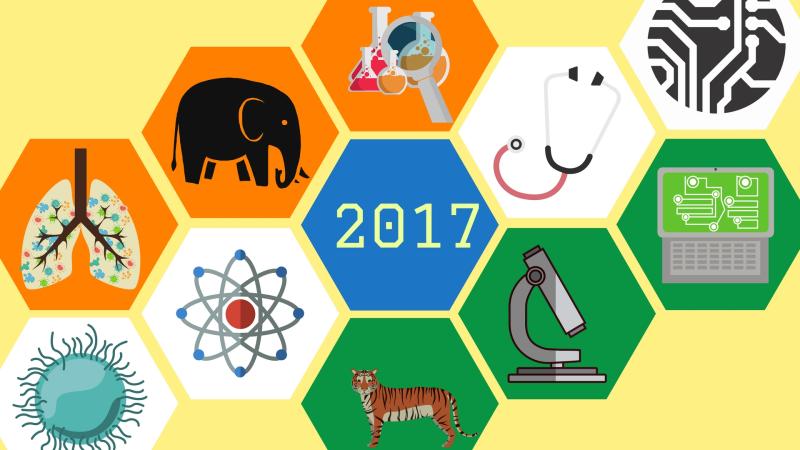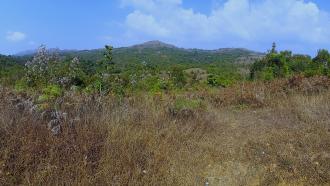
Illustration : Purabi Deshpande / Research Matters
Science in India is on a great momentum in the last few decades, thanks to the talent and the infrastructure. Our achievements in fields ranging from astronomy, to biology, to chemistry and agriculture, there are so many to be proud about! But how different was 2017? What were some of the significant research highlights from the Indian scientific community? Below are ten breakthroughs we have picked, in no particular order.
1. ISRO -- propelling India’s success in space science
Indian Space Research Organisation (ISRO) had a year filled with remarkable achievements. Our scientists set a world record with the launch of the largest number of satellites in a single launch, and a rocket launch (GSLV Mark III) with the heaviest payload. ISRO has now established its ability to launch satellites on a commercial scale with multiple multi-satellite launches. Providing a reliable, low cost option to its customers, ISRO launched a whopping 130 customer satellites in 2017 alone! And not just the numbers, ISRO launched satellites ranging from 3136 kg to a meagre 4g! Continuing with its tradition to encourage student participation, ISRO also launched another student satellite this year.
2. Hitting the nail on the head with monsoon prediction
The monsoon rains are of extreme importance to the people of India--not only because of the much respite they bring after a scathing summer, but also because our agriculture is heavily dependent on these rains. Hence, accurately predicting its arrival, duration and intensity is paramount. Determining factors that influence the onset of monsoon, and understanding extreme rainfall events and their influence on the overall rainfall patterns in the country are some research challenges our scientists seem to have cracked in 2017. In addition, the ‘Monsoon Mission’ program is set to extend its facilities for disaster management too, thus saving more lives.
3. Saraswati - A supercluster discovered by our super scientists
The year 2017 was big for Indian astronomers for two things -- one, the Nobel Prize for the discovery of Gravitational Waves that had some contribution from our scientists, and two, was the discovery of a supercluster of galaxies. Named Saraswati, after the Indian goddess of music, art and knowledge, the supercluster is estimated to contain billions of stars, planets, gases, dark matter and other bodies. In addition, this would also help astronomers understand much about the composition of our universe and its mysterious past.
4. Scientists decipher what is causing a geoid low in the Indian Ocean
Oceans have a lot of mysteries buried deep inside and scientists have unearthed one such mystery in the Indian Ocean--the mystery of the missing mass. In a pathbreaking seismological study, researchers have examined the Indian Ocean Geoid Low (IOGL), a point of abnormally low gravity, caused by the deficit in the mass of Earth below IOGL. While there were a few theories in the past explaining the cause, none of them were convincing. Now, in a new study published this year, scientists from India and Germany seem to have finally succeed in their attempt to explain this phenomenon. They suggest that lighter material, present in the upper and mid-mantle (the layer below the Earth’s crust) just below the IOGL, could be responsible for this anomaly. The researchers used various seismographic tools and computer analyses, to providing a satisfying explanation for a long standing mystery, putting to rest all speculations.
5. Alarming stories of climate change
We know climate change is real. But how real is it and what is exactly changing? In a series of studies, scientists unravelled the gory face of climate change. Melting glaciers in the Himalayas is a significant threat posing the country, thanks to the warming climate. Cities, that were once home to plenty of trees, are now concrete jungles. Habitat destruction, either due to climate or due to human activities, is disturbing our precarious relationship with animals, leading to an increase in human animal conflicts. On the brighter side, scientists are also showing us how to deal with climate change. But will we succeed? Time can tell.
6. An all-out war on cancer
Scientists all over the world are fighting cancer--the cause of 1 in 6 deaths in the world--with new therapies and drugs discovered every other day. And India is no different. Indian researchers contributed a significant share in the fight against cancer with research spanning across fields of genetics, computational biology, nanotechnology and bioinformatics. While a few studies explored natural remedies, some suggested unexpected possible substances--like red wine--that could help fight cancer! In fact, scientists in the country also indigenously developed an anti-cancer drug called disarib, which is now ready for pre-clinical trials.
7. Indian scientists address a 50 year old problem in buoyancy driven turbulence
Scientists from the Indian Institute of Technology, Kanpur, have been able to address a critical problem in buoyancy-driven turbulence that had remained unsolved for more than half a century. Using supercomputers, they countered some of the old prejudices, put the pieces together, and have come up with a consistent theory of buoyancy-driven turbulence. This discovery, the scientists say, would help in better modeling of such flows including those in the atmosphere and interiors of our Earth.
8. A made-in-India transistor that can make India’s IoT technology a reality
Researchers at the Indian Institute of Technology Bombay (IITB), in a collaborative effort with ISRO’s Semi-Conductor Labs (SCL), Chandigarh, have developed a completely indigenous Bipolar Junction Transistor (BJT) that can work with the other type of transistor, called BiCMOS. BJTs are touted to play a big role in the Internet of things (IoT) applications. A major milestone of Centre for Excellence in Nanoelectronics (CEN) under the “Make in India” initiative, the indigenous transistor reduces the dependence on multinational semiconductor manufacturers and is a major advantage for India’s space and defence projects.
9. Fighting the drug resistant tuberculosis
India bears a disproportionately large burden of world’s tuberculosis (TB) rate, and our researchers are leaving no stone unturned in their fight against the disease that has killed over 4 lakh people in the country in 2016 alone. A major challenge in fighting TB is the emergence of drug resistant strains of the TB bacteria, which are now immune to most antibiotics. In a pathbreaking study this year, our scientists attempt to answer how TB bacteria develop resistance to most antibiotics, and try to find ways to reverse this drug resistance. In addition, studies on identifying other drug targets that can kill the TB bacteria are gaining momentum. Hope is that we might soon succeed in this fight.
10. Preventing our cities from becoming trash bins
Managing the large amount of waste generated in a small area is one of the major challenges of urban living. Researcher suggest alternatives to open dumping, which is not just insufficient, it pollutes water bodies, spoils the environment and ruins aesthetics too. They seek new ways to recycle the growing e-waste, so that toxic emissions are minimal. While seeking technology solutions to take care of the biowaste, we may actually discover that biowaste is a treasure!






